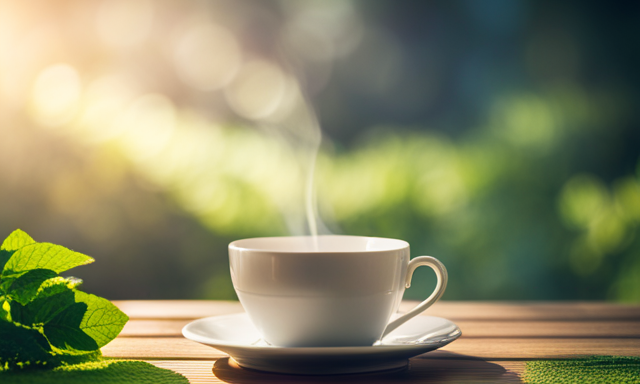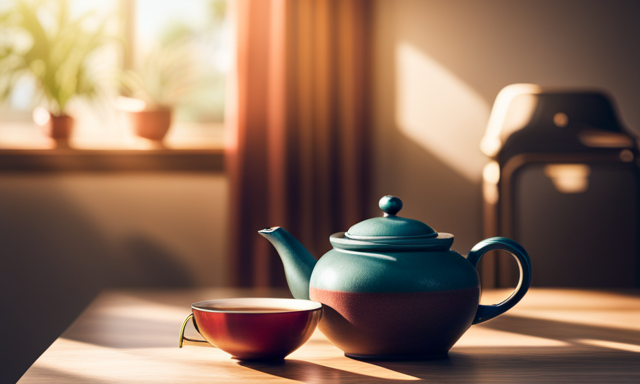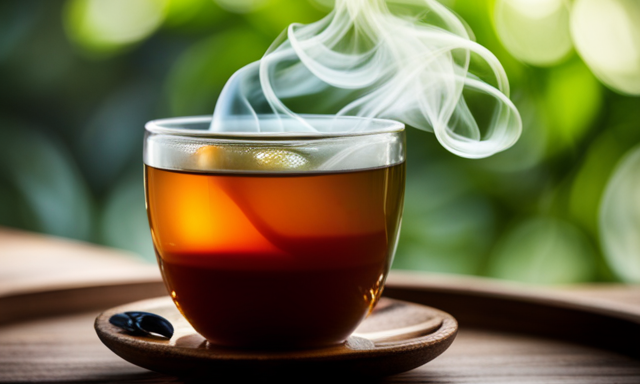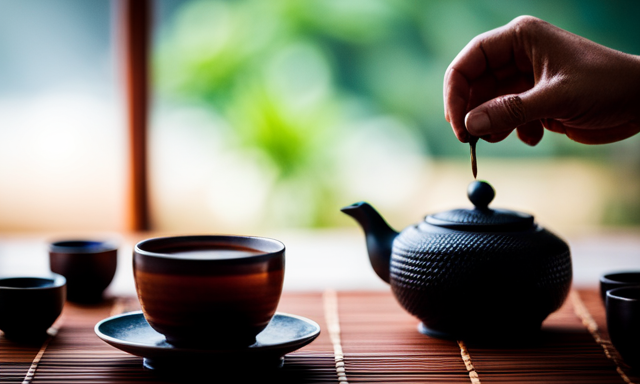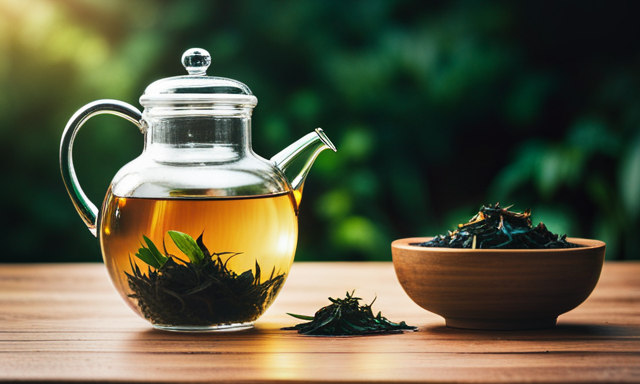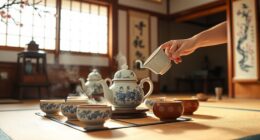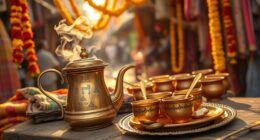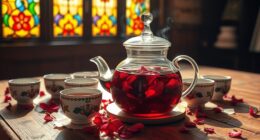I’ve always been fascinated by the rich and aromatic oolong tea served in restaurants. The way the flavors dance on my palate and the soothing fragrance that fills the air is simply irresistible.
So, I set out on a mission to learn how to make oolong tea just like the restaurants do. Through my research and experimentation, I’ve discovered some tried and true methods that I can’t wait to share with you.
In this article, I will guide you step by step on how to brew the perfect cup of oolong tea that rivals your favorite restaurant’s. We’ll start by choosing high-quality oolong tea leaves and measuring the right amount. Then, we’ll dive into preparing the water at the correct temperature and using the right tea ware. I’ll also share some tips on rinsing the tea leaves and experimenting with different steeping methods.
So, get ready to enhance your tea-drinking experience and impress your taste buds with the exquisite flavors of oolong tea.
Key Takeaways
- Choose high-quality oolong tea leaves by comparing different varieties and looking for tightly rolled leaves with a vibrant color.
- Measure the right amount of tea using a kitchen scale and adjust the measurements based on personal preference.
- Prepare water at the correct temperature based on the type of oolong tea, ranging from 180°F to 200°F.
- Use the right tea ware, such as clay teapots, Gaiwan, small porcelain cups, and a fine mesh strainer, to enhance the taste and brewing experience.
Choose High-Quality Oolong Tea Leaves
To make oolong tea like restaurants, you’ll want to start by choosing high-quality oolong tea leaves that are beautifully aromatic and rich in flavor. Choosing the right tea leaves is crucial in achieving the desired taste and aroma in your oolong tea.
There are various types of oolong tea available, each with its own unique characteristics. Take the time to compare different tea varieties and select the one that suits your preference. Look for leaves that are tightly rolled and have a vibrant color. These are indications of good quality.
Once you’ve chosen the perfect oolong tea leaves, you can move on to the next step of measuring the right amount of tea. This ensures that you achieve the perfect balance of flavors in your oolong tea creation.
Measure the Right Amount of Tea
Ensure you’ve got just the right amount of those delicate tea leaves, so your brew turns out as exquisite as the ones served at your favorite tea spot. When it comes to measuring techniques for oolong tea, accuracy is key.
Start by using a kitchen scale to weigh the desired amount of tea leaves. Generally, a ratio of 1 teaspoon of leaves per 8 ounces of water works well, but you can adjust based on personal preference. Remember that different tea flavors may require slightly different measurements. For a lighter flavor, use fewer leaves, while for a stronger taste, increase the amount slightly.
By measuring the right amount of tea, you ensure a balanced and flavorful brew every time.
Now, let’s move on to preparing the water at the correct temperature for the next step.
Prepare the Water at the Correct Temperature
Get ready to experience the perfect cup of oolong tea by getting the water at just the right temperature. Temperature control is crucial in brewing oolong tea to ensure optimal flavor extraction. The importance of water quality cannot be overstated as it directly affects the taste of your tea. To achieve the ideal water temperature, refer to the table below:
| Tea Type | Water Temperature |
|---|---|
| Light | 180°F (82°C) |
| Medium | 190°F (88°C) |
| Dark | 200°F (93°C) |
By using water at the correct temperature, you can unlock the full potential of the oolong tea leaves, allowing their flavors to blossom. Once you have mastered this crucial step, you can move on to the next section about using the right tea ware to enhance your oolong tea experience.
Use the Right Tea Ware
Using the right tea ware is the key to elevating your oolong tea experience and unleashing its true potential. Tea ware selection plays a crucial role in enhancing the flavor and aroma of your oolong tea. Here are four essential factors to consider when choosing your tea ware:
-
Teapot: Opt for a clay teapot, such as Yixing or Tokoname, as they absorb the flavors of the tea over time, enhancing its taste with each brew.
-
Gaiwan: This traditional Chinese tea brewing vessel allows for precise control over steeping time and water temperature, resulting in a perfectly balanced cup of oolong tea.
-
Tea cups: Use small, porcelain cups to fully appreciate the color and clarity of oolong tea. The thin walls help retain the heat and allow the tea to cool down gradually.
-
Tea strainer: Invest in a fine mesh strainer to filter out any tea leaves or particles, ensuring a smooth and enjoyable tea-drinking experience.
Now that you’ve selected the proper tea ware, let’s move on to the next step: rinsing the tea leaves.
Rinse the Tea Leaves
To fully unlock the flavors and aromas of your oolong tea, start by rinsing the tea leaves to remove any impurities and prepare them for brewing. Rinsing the oolong tea leaves is an essential step in the tea-making process that shouldn’t be overlooked. By rinsing the leaves, you can remove any dust or dirt that may have accumulated during storage and transportation. It also helps to wake up the leaves, allowing them to release their delicate flavors more easily.
There are various rinsing techniques you can explore, such as a quick rinse with hot water or a brief soak followed by a gentle swishing motion. Each method may yield slightly different results, so feel free to experiment and find the one that suits your taste preferences.
Once the leaves are rinsed, you can move on to steeping the tea for the proper time, which will further enhance its flavor profile.
Steep the Tea for the Proper Time
After rinsing the tea leaves, the next step to making oolong tea like restaurants is to steep the tea for the proper time. This is crucial in order to extract the full flavor and aroma from the leaves.
Oolong tea can vary in its steeping time depending on the desired strength and taste. Generally, it’s recommended to steep oolong tea for about 3-5 minutes. However, you can experiment with different steeping times to find your preferred flavor profile.
Steeping the tea for a shorter time will result in a lighter, more delicate cup, while steeping it for longer will yield a stronger, bolder brew. To enhance the flavor even further, you can add additives like lemon, honey, or mint to your brewed oolong tea. These additions can bring out different nuances and create a unique taste experience.
Now, let’s move on to the next step and discuss how to experiment with steeping methods to further customize your oolong tea.
Experiment with Steeping Methods
By exploring different steeping methods, you’ll unlock a world of flavor possibilities and transform your oolong tea into a personalized masterpiece.
One way to experiment is by trying different tea blends. Oolong tea comes in various blends, such as traditional, floral, fruity, and roasted. Each blend offers a unique flavor profile, allowing you to discover your preference.
Another factor to consider is the steeping temperature. Different teas require different temperatures for optimal flavor extraction. For oolong tea, a general guideline is to use water that’s around 190-200°F (88-93°C). However, don’t be afraid to play around with the temperature to find what suits your taste.
Once you’ve steeped your tea using your preferred blend and temperature, you can move on to the next step of enjoying the aroma and appearance of the tea, which we’ll explore next.
Enjoy the Aroma and Appearance of the Tea
Now that we’ve experimented with different steeping methods, let’s take a moment to appreciate the aroma and appearance of our oolong tea.
This is an essential part of tea culture and adds to the overall experience of drinking oolong tea. As you pour the tea into your cup, you’ll notice its vibrant color and enticing aroma. Take a moment to inhale the fragrance deeply, allowing it to awaken your senses.
The visual appeal of the tea, with its beautiful hues ranging from light amber to deep golden brown, is a testament to the quality and craftsmanship of the leaves. As you sip your oolong tea, you can also enjoy the numerous health benefits it offers, such as boosting metabolism and improving digestion.
Now, let’s move on to the next section and savor the flavor of oolong tea.
Savor the Flavor of Oolong Tea
Indulge in the exquisite taste of oolong tea, savoring its delicate notes and rich flavors. Oolong tea is known for its wide range of flavors, from floral and fruity to nutty and toasty. Each variety offers a unique taste experience that can be explored and enjoyed.
Some popular flavors include orchid, peach, and almond. In addition to its delightful taste, oolong tea also offers numerous health benefits. It’s rich in antioxidants that can help boost metabolism, support weight loss, and improve heart health. Oolong tea has also been linked to reducing the risk of chronic diseases such as diabetes and cancer.
To store your oolong tea properly for future use, it’s important to keep it in an airtight container away from moisture and sunlight.
Store Your Oolong Tea Properly for Future Use
To ensure your oolong tea stays fresh and flavorful for future enjoyment, remember to store it in an airtight container away from moisture and sunlight. This is crucial for prolonging the tea’s freshness and preserving its delightful flavors. When storing tea leaves, it’s important to keep in mind that they are sensitive to moisture, light, heat, and strong odors. To help you in storing your oolong tea properly, here are some tips:
-
Choose an airtight container: Opt for a container that can seal tightly to prevent air and moisture from entering.
-
Keep it away from light: Store your tea in a dark place, such as a pantry or cupboard, to protect it from direct sunlight.
-
Ensure dry conditions: Avoid storing your tea near any source of moisture, such as the kitchen sink or refrigerator.
-
Avoid strong odors: Keep your tea away from strong-smelling substances as they can affect the flavor of the tea.
By following these guidelines, you can prolong the freshness and quality of your oolong tea, ensuring a delightful cup every time.
Frequently Asked Questions
What are the different types of oolong tea available?
There are various types of oolong tea available, each with its unique flavor profile and brewing methods. Popular oolong tea flavors include Tie Guan Yin, Da Hong Pao, and Oriental Beauty.
Can I use a regular teapot instead of specific tea ware?
Using a regular teapot for making oolong tea is perfectly fine. However, using specific tea ware for oolong tea brewing has its benefits. It helps to bring out the flavors and aromas, resulting in a more authentic and enjoyable tea experience.
How do I know if I have brewed the tea for the right amount of time?
To determine the optimum brewing time for oolong tea, observe the color and aroma. Steep it for 3-5 minutes for a lighter taste, or 5-7 minutes for a stronger flavor. Adjust brewing time based on personal taste preferences.
Are there any health benefits associated with drinking oolong tea?
Drinking oolong tea can have health benefits. It may aid in weight loss by boosting metabolism and reducing fat absorption. It can also promote heart health by lowering cholesterol levels and reducing the risk of heart disease.
Can I reuse the tea leaves for multiple steepings?
Sure! Reusing tea leaves for multiple steepings is like getting the most out of a good book. Each time you steep, the flavors unfold differently, giving you a new experience with every sip. It’s a tea lover’s delight!
Conclusion
Well, after following all these steps to make oolong tea like restaurants, I have to say, it’s quite the process. Who knew making a simple cup of tea could be so intricate? But hey, if you’re willing to put in the time and effort, you can enjoy a cup of oolong tea that rivals any fancy restaurant’s.
Just remember to savor every sip and appreciate the fact that you’ve become a tea connoisseur in the process. Cheers to your newfound tea-making skills!


